(Banner photo © Mark Moore)
Steampunk, the artful blending of Victorian/Edwardian antiquity with modern technology, is an irresistible “best of all possible worlds” for millions. Do a search on Steampunk and get ready for overwhelm–tons of blogs, books and forums relating how to capture that perfect time merge in jewelry, computer equipment, art and clothing.
When it comes to food, though, Steampunk is silent, or nearly so. Yet many of Steampunk’s tenets–to celebrate the history of mechanical ingenuity and its aesthetics, to appreciate the high tech of a lower tech era–are lived out every day in restaurant kitchens and food science laboratories. Steam, historically speaking, denotes progress and forward momentum–steam propelled engines, heat and energy generation. Steam also revolutionized food production and preservation; we owe a lot to steam geekery within the food world. But Steampunk is not limited to steamed food. What exactly would Steampunk cuisine look like? More importantly, how does it taste?
Food as Art and Science
We’re living in a dichotomy of love for technology and a vague sense that too many hands are touching our stuff. We yearn for food in its most natural form, the low-tech, straight-from-the-soil organisms that have not been processed. The raw food movement continues to gain momentum, creating in itself a progressively sophisticated means of preparing foods without high heat. In Los Angeles in particular restaurants like Cru, Juilano’s Raw and Planet Raw continue to amaze palates with their artistry and yes, science more than 10 years after Roxanne Klein and Charlie Trotter effectively introduced the concept outside of the hard core health food communities.
And at the same time, we have great chefs like Grant Aschatz, Homaro Cantu and Wylie Dufresne, visionaries who use food in scientific experiments, seeking new and meaningful ways to transform its texture, flavor and appearance.
Modernist Cuisine, a community site with forums, events and news is arguably a direct offshoot of both highly technical food preparation and of getting back to basics. From the launch of Modernist Cuisine, the series of cookbooks by Nathan Myhrvold, Chris Young and Maxime Bilet, the site itself grew out of the food community’s growing fascination with food science.
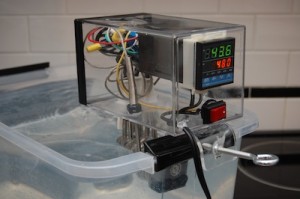
Food geek Scott Heimendinger showed the world how to construct a homemade sous vide machine. Photo © Scott Heimendinger/www.SeattleFoodGeek.com
And food innovation is not just happening in the professional kitchen. Scott Heimendinger captured the attention of thousands and The New York Times last year when he decided to make his own sous vide water bath, using common components like an immersion heater, aquarium pump and Krazy Glue. Coincidentally enough, the former IBM exec turned home cook turned award-winning food blogger (Seattle Food Geek), is now director of business development at Modernist Cuisine.
Food Before Technology
To better understand man’s drive to continually improve upon his food source and cooking methods, think about the centuries before 1800, when simple cooking was an oxymoron. Baking bread was a time-consuming endeavor that included grinding flour (or trekking a couple hundred rods to the nearest mill), building a wood fire with just the right heat level, fiddling with temperamental yeast and the bone-compressing monotony of hand-kneading dough.
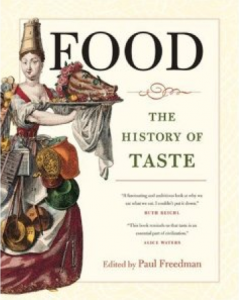
Editor Paul Freedman gathers essays from historians on food, but more importantly taste, through the ages in the book, Food: The History of Taste.
Cooking methods changed very little between the Late Middle Ages and the Industrial Revolution. Then the mid-19th century came along, launching an explosion of cooking improvements, from heat-conducting metals used in cookware to refrigeration, canning and preserving sealants, greater access to imported goods, and of course, the all-important cookstove.
“Ovens made of cast-iron and brass…had an ingenious system that combined cooking and water heating,” writes Hans J. Teuteberg in Food: The History of Taste (University of California Press).
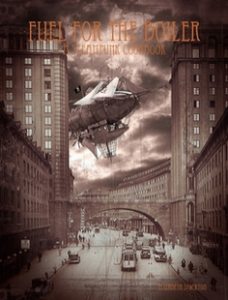
Author Elizabeth Stockton credits the many Steampunk community members who contributed their recipes to this cookbook, which as one reviewer says "captures the spirit of the Steampunk movement in a flawless and fun way."
Steampunk cuisine reflects both an appreciation for the food and the method with which it was cooked. It is also a direct reflection of the people preparing it. Elizabeth Stockton, author of Fuel for the Boiler: A Steampunk Cookbook notes in the introduction that “food…will always be a unifying factor in humankind. Societies have been built on it and wars have been fought over it.” As part of Brass Goggle, one of the biggest online forums devoted to Steampunk, Stockton began an exchange of recipes and the response was so overwhelming she compiled all of the contributions into a cookbook. “This book (was) penned by the many individuals of the steampunk community,” she continues.
Steam-Powered Twists
When I was a student in France back in the 80s, a bunch of us étrangeres took a cooking class. My most vivid memory is learning to use a pressure cooker to make coq au vin–or maybe it was pot au feu. In any case it was chicken in a pot that didn’t look anything like the Revere pots I grew up with. Some of the older versions look about as Steampunk as one can get.
The results were delicious but the process was slightly intimidating. Pressure cookers have a special lid that clamps down securely on the pot. A small valve opens and closes, to control the steam. Its advantages include reducing cook time and retaining more flavor, whether you poach, braise or simply simmer. You don’t hear much about pressure cookers in the home–a small but devoted group continues to use them and extol their benefits, though, including Lorna Sass who wrote the classic cookbook, Pressure Perfect.
“If you can make a lentil soup in ten minutes,” Sass says, “you are much more likely to make one and not eat out or eat junk food.” Why Europeans use pressure cooker more than Americans, Sass replies simply that “Europeans aren’t afraid of them.”
The Steampunk Chef
In all of the time spent pondering the posits and vagaries of Steampunk cuisine and what it is, a Midwestern gentleman has been quietly and capably defining the genre.
Aaron Egan, a self-described “Steampunk Chef” with his own blog, Facebook page and website, can be found doctoring a 100-year old recipe for Chicken Paillard for a few of his closest friends when he is not working the night shift at his restaurant job in Detroit. “If you can sew a steampunk wardrobe, write a steampunk story, and create a steampunk computer… why shouldn’t you cook steampunk food?” asks the subtitle of his fascinating cooking blog, Steampunk Cookery.
“In my approach, (Steampunk cuisine) is about taking old inspiration and applying new understandings to it,” Egan explains. “I take a recipe for pork loin, and know that I can cook it safely to 145°F, rather than ‘until done the whole way through.’ I know that I can serve it with applesauce, though not applesauce you would find in a jar, but perhaps an apple butter thinned down or a hard apple cider reduction.”
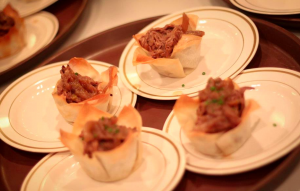
Egan's 15-hour brisket, steeped in spices and red wine, is served in phyllo cups topped with an onion, leek and garlic mixture. (Photo © Blue Dragon Media)
Egan’s Steampunk approach to cooking is both unabashedly lavish and purely rational. He enjoys studying and deconstructing old recipes, poring through classic cookbooks like Mrs. Beeton’s Book of Household Management (1861), Buckeye Cookery (1877) and The White House Cookbook (c. 1910). He often searches for obscure culinary relics through the Feeding America library at Michigan State University. “It’s a spectacular resource, both from the standpoint of a researcher tracking the development of recipes and food customs through history, and from the cook seeking inspiration from a specific place and time,” Egan says.
Though much preferring a “sober evening with my closest friends to a Bacchanal with strangers,” Egan’s devotion to recasting historic cuisine in modern times has brought fame both inside and outside Detroit. He has presented panels at Teslacon, one of the country’s largest “immersion” Steampunk events held annually in Madison, Wisconsin, as well as the World Steam Expo in Dearborn, Michigan. And although committed to unlocking the secrets of recipes past, Egan admits to a modern-day fascination with sous vide and other modernist developments in food.
But like all else, he has a perfectly Steampunk explanation for that. “The Victorians loved technology and were happy to adapt any fanciful or reasonable idea that came their way–up to and including ‘health-promoting’ electrified underwear–so why shouldn’t I do the same?”
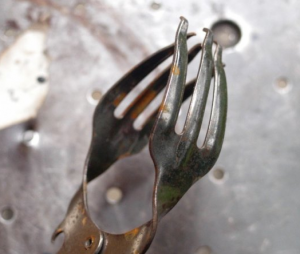
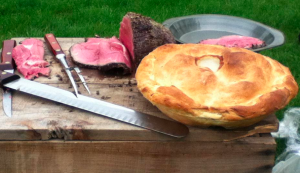
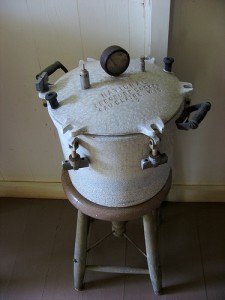
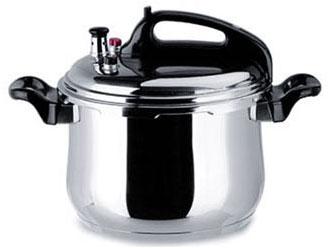
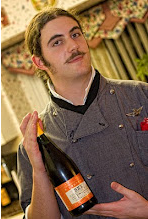
That old pressure cooker reminds me of the ones they still sometimes use over in Afghanistan. (They also make good casings for IEDs, sadly.)
Erika,
what a great and informative post! I had no idea about Steampunk cuisine until your post. Bravo. 😉